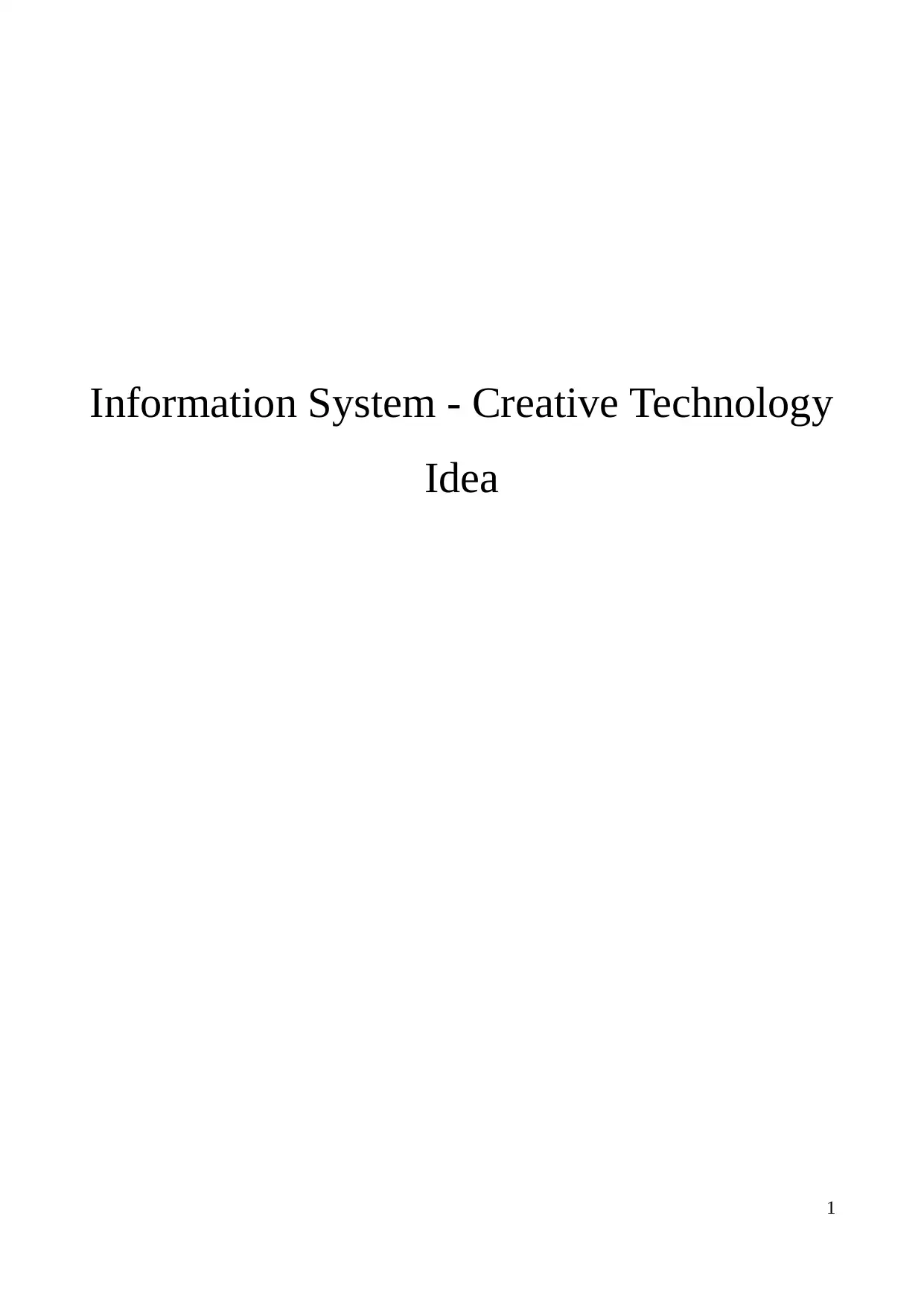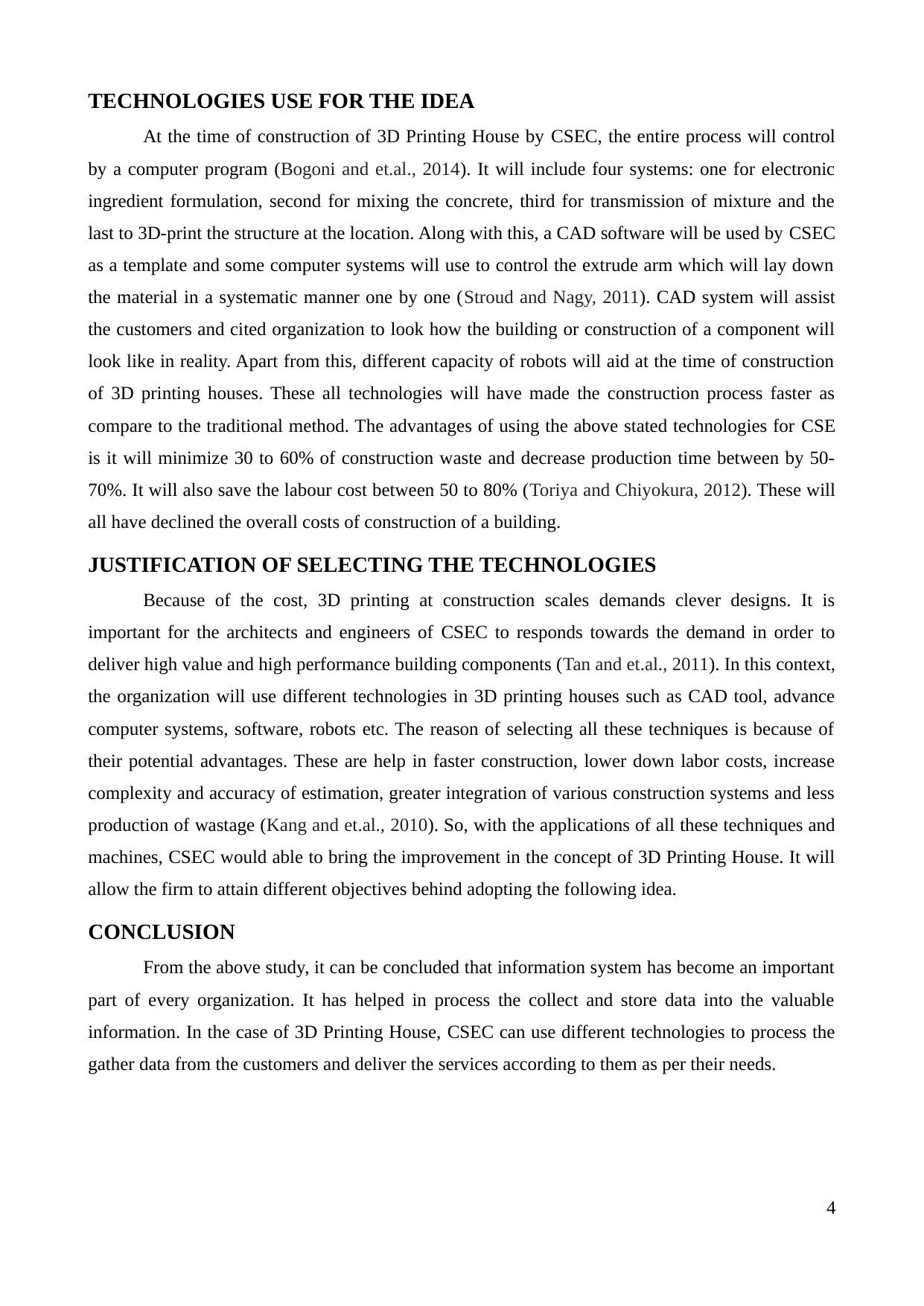Information System: Creative Technology Idea for 3D Printing House
VerifiedAdded on 2020/02/03
|5
|1263
|58
Report
AI Summary
This report provides an overview of the 3D Printing House concept, focusing on how information systems can be utilized to enhance construction processes. The report begins with an introduction to information systems and their importance, using The China State Construction Engineering Corporation (CSEC) as a case study. It then describes the 3D Printing House idea, which involves using 3D printing technology to construct buildings and components, including the use of recycled materials. The objectives of this idea, such as constructing durable buildings, recycling industrial waste, reducing construction time and costs, and minimizing environmental impact, are outlined. The report also details the technologies used, including computer programs, CAD software, and robots, and justifies the selection of these technologies based on their potential benefits such as faster construction, lower labor costs, and reduced waste. The report concludes by emphasizing the significance of information systems in the context of 3D Printing House and their role in data collection and efficient service delivery. References to relevant books, journals, and online resources are also included.

Information System - Creative Technology
Idea
1
Idea
1
Paraphrase This Document
Need a fresh take? Get an instant paraphrase of this document with our AI Paraphraser

Table of Contents
INTRODUCTION................................................................................................................................3
DESCRIPTION OF IDEA...................................................................................................................3
OBJECTIVES OF THE IDEA.............................................................................................................3
TECHNOLOGIES USE FOR THE IDEA...........................................................................................4
JUSTIFICATION OF SELECTING THE TECHNOLOGIES............................................................4
CONCLUSION....................................................................................................................................4
REFERENCES.....................................................................................................................................5
2
INTRODUCTION................................................................................................................................3
DESCRIPTION OF IDEA...................................................................................................................3
OBJECTIVES OF THE IDEA.............................................................................................................3
TECHNOLOGIES USE FOR THE IDEA...........................................................................................4
JUSTIFICATION OF SELECTING THE TECHNOLOGIES............................................................4
CONCLUSION....................................................................................................................................4
REFERENCES.....................................................................................................................................5
2

INTRODUCTION
An information system can be considered as an organized system for the collecting, storing,
organizing and communicating the information. It is based on the study of complementary networks
that use by organizations and their personnel to gather, process, create and distribute the data in
effective form (Luu and et.al., 2014). The present study is based on information system and to
understand its importance, The China State Construction Engineering Corporation (CSEC) is taking
into the consideration. It is the third largest construction company in the world and currently
working on the 3D Printing House concept.
DESCRIPTION OF IDEA
3D Printing House refers to a technology that use 3D printing as a core method to construct
buildings and other construction components. In this technology, the machines are automatically
integrated with semi and fully automated production lines. Under this idea, a 3D printer will use by
CSEC to mix concrete and different kinds of industrial waste where quick drying cement will mix
with a special hardening agent to build a building within the less time (Cooke, 2016).
In the construction industry, waste materials are the biggest issue. But in 3D Printing House,
concept, the required raw material will produce at each stage of project by CSEC. The ink that will
be used in the printing prepare from recycled plastic waste. The materials that will use at the time of
constructing 3D Printing House are industrial wastage such as tailings, glasses, plastic etc. The
following ideas will assist the company to develop more customized designs as per the needs and
requirements of the customers. In addition to this, to build a 3D printing house, three methods will
be used: extrusion, power bonding and additive welding (Scott, 2016). The following idea will have
wide applications in majorly four sectors: private, commercial, public and industrial sector.
OBJECTIVES OF THE IDEA
There will several objectives of the 3d printing house idea for CSEC which are as follows:
To construct more durable buildings that enough to withstand against the earthquake.
To recycle the wastage of industries and use it to build a shock proof buildings.
To decrease production time, labour costs, conduction wastes and overall constructing cost of a
house.
To minimize the requirement of quarried stone and other materials resulting in a construction
method that is both cost effective and environmental friendly.
To becomes change the construction concept in the world.
To reduce the emission of green house gases during the process of construction of buildings.
3
An information system can be considered as an organized system for the collecting, storing,
organizing and communicating the information. It is based on the study of complementary networks
that use by organizations and their personnel to gather, process, create and distribute the data in
effective form (Luu and et.al., 2014). The present study is based on information system and to
understand its importance, The China State Construction Engineering Corporation (CSEC) is taking
into the consideration. It is the third largest construction company in the world and currently
working on the 3D Printing House concept.
DESCRIPTION OF IDEA
3D Printing House refers to a technology that use 3D printing as a core method to construct
buildings and other construction components. In this technology, the machines are automatically
integrated with semi and fully automated production lines. Under this idea, a 3D printer will use by
CSEC to mix concrete and different kinds of industrial waste where quick drying cement will mix
with a special hardening agent to build a building within the less time (Cooke, 2016).
In the construction industry, waste materials are the biggest issue. But in 3D Printing House,
concept, the required raw material will produce at each stage of project by CSEC. The ink that will
be used in the printing prepare from recycled plastic waste. The materials that will use at the time of
constructing 3D Printing House are industrial wastage such as tailings, glasses, plastic etc. The
following ideas will assist the company to develop more customized designs as per the needs and
requirements of the customers. In addition to this, to build a 3D printing house, three methods will
be used: extrusion, power bonding and additive welding (Scott, 2016). The following idea will have
wide applications in majorly four sectors: private, commercial, public and industrial sector.
OBJECTIVES OF THE IDEA
There will several objectives of the 3d printing house idea for CSEC which are as follows:
To construct more durable buildings that enough to withstand against the earthquake.
To recycle the wastage of industries and use it to build a shock proof buildings.
To decrease production time, labour costs, conduction wastes and overall constructing cost of a
house.
To minimize the requirement of quarried stone and other materials resulting in a construction
method that is both cost effective and environmental friendly.
To becomes change the construction concept in the world.
To reduce the emission of green house gases during the process of construction of buildings.
3
⊘ This is a preview!⊘
Do you want full access?
Subscribe today to unlock all pages.

Trusted by 1+ million students worldwide

TECHNOLOGIES USE FOR THE IDEA
At the time of construction of 3D Printing House by CSEC, the entire process will control
by a computer program (Bogoni and et.al., 2014). It will include four systems: one for electronic
ingredient formulation, second for mixing the concrete, third for transmission of mixture and the
last to 3D-print the structure at the location. Along with this, a CAD software will be used by CSEC
as a template and some computer systems will use to control the extrude arm which will lay down
the material in a systematic manner one by one (Stroud and Nagy, 2011). CAD system will assist
the customers and cited organization to look how the building or construction of a component will
look like in reality. Apart from this, different capacity of robots will aid at the time of construction
of 3D printing houses. These all technologies will have made the construction process faster as
compare to the traditional method. The advantages of using the above stated technologies for CSE
is it will minimize 30 to 60% of construction waste and decrease production time between by 50-
70%. It will also save the labour cost between 50 to 80% (Toriya and Chiyokura, 2012). These will
all have declined the overall costs of construction of a building.
JUSTIFICATION OF SELECTING THE TECHNOLOGIES
Because of the cost, 3D printing at construction scales demands clever designs. It is
important for the architects and engineers of CSEC to responds towards the demand in order to
deliver high value and high performance building components (Tan and et.al., 2011). In this context,
the organization will use different technologies in 3D printing houses such as CAD tool, advance
computer systems, software, robots etc. The reason of selecting all these techniques is because of
their potential advantages. These are help in faster construction, lower down labor costs, increase
complexity and accuracy of estimation, greater integration of various construction systems and less
production of wastage (Kang and et.al., 2010). So, with the applications of all these techniques and
machines, CSEC would able to bring the improvement in the concept of 3D Printing House. It will
allow the firm to attain different objectives behind adopting the following idea.
CONCLUSION
From the above study, it can be concluded that information system has become an important
part of every organization. It has helped in process the collect and store data into the valuable
information. In the case of 3D Printing House, CSEC can use different technologies to process the
gather data from the customers and deliver the services according to them as per their needs.
4
At the time of construction of 3D Printing House by CSEC, the entire process will control
by a computer program (Bogoni and et.al., 2014). It will include four systems: one for electronic
ingredient formulation, second for mixing the concrete, third for transmission of mixture and the
last to 3D-print the structure at the location. Along with this, a CAD software will be used by CSEC
as a template and some computer systems will use to control the extrude arm which will lay down
the material in a systematic manner one by one (Stroud and Nagy, 2011). CAD system will assist
the customers and cited organization to look how the building or construction of a component will
look like in reality. Apart from this, different capacity of robots will aid at the time of construction
of 3D printing houses. These all technologies will have made the construction process faster as
compare to the traditional method. The advantages of using the above stated technologies for CSE
is it will minimize 30 to 60% of construction waste and decrease production time between by 50-
70%. It will also save the labour cost between 50 to 80% (Toriya and Chiyokura, 2012). These will
all have declined the overall costs of construction of a building.
JUSTIFICATION OF SELECTING THE TECHNOLOGIES
Because of the cost, 3D printing at construction scales demands clever designs. It is
important for the architects and engineers of CSEC to responds towards the demand in order to
deliver high value and high performance building components (Tan and et.al., 2011). In this context,
the organization will use different technologies in 3D printing houses such as CAD tool, advance
computer systems, software, robots etc. The reason of selecting all these techniques is because of
their potential advantages. These are help in faster construction, lower down labor costs, increase
complexity and accuracy of estimation, greater integration of various construction systems and less
production of wastage (Kang and et.al., 2010). So, with the applications of all these techniques and
machines, CSEC would able to bring the improvement in the concept of 3D Printing House. It will
allow the firm to attain different objectives behind adopting the following idea.
CONCLUSION
From the above study, it can be concluded that information system has become an important
part of every organization. It has helped in process the collect and store data into the valuable
information. In the case of 3D Printing House, CSEC can use different technologies to process the
gather data from the customers and deliver the services according to them as per their needs.
4
Paraphrase This Document
Need a fresh take? Get an instant paraphrase of this document with our AI Paraphraser

REFERENCES
Books and Journals
Bogoni, L. and et.al., 2014. Computer-aided detection (CAD) for CT colonography: a tool to
address a growing need. The British Journal of Radiology.
Kang, L.S. and et.al., 2010. Improved link system between schedule data and 3D object in 4D CAD
system by using WBS code. KSCE Journal of Civil Engineering. 14(6). pp.803-814.
Luu, J. and et.al., 2014. VTR 7.0: Next generation architecture and CAD system for FPGAs. ACM
Transactions on Reconfigurable Technology and Systems (TRETS). 7(2). p.6.
Stroud, I. and Nagy, H., 2011. Solid modelling and CAD systems: how to survive a CAD system.
Springer Science & Business Media.
Tan, M. and et.al., 2011. A novel computer-aided lung nodule detection system for CT
images. Medical physics. 38(10). pp.5630-5645.
Toriya, H. and Chiyokura, H., 2012. 3D CAD: principles and applications. Springer Publishing
Company.
Online
Cooke, L., 2016. 3D-printed house in China can withstand an 8.0 earthquake. [Online]. Available
through: <http://inhabitat.com/3d-printed-house-in-china-can-withstand-an-8-0-
earthquake/>. [Accessed on 14th October 2016].
Scott, C., 2016. Chinese Construction Company 3D Prints an Entire Two-Story House On-Site in 45
Days. [Online]. Available through: <https://3dprint.com/138664/huashang-tengda-3d-print-
house/>. [Accessed on 14th October 2016].
5
Books and Journals
Bogoni, L. and et.al., 2014. Computer-aided detection (CAD) for CT colonography: a tool to
address a growing need. The British Journal of Radiology.
Kang, L.S. and et.al., 2010. Improved link system between schedule data and 3D object in 4D CAD
system by using WBS code. KSCE Journal of Civil Engineering. 14(6). pp.803-814.
Luu, J. and et.al., 2014. VTR 7.0: Next generation architecture and CAD system for FPGAs. ACM
Transactions on Reconfigurable Technology and Systems (TRETS). 7(2). p.6.
Stroud, I. and Nagy, H., 2011. Solid modelling and CAD systems: how to survive a CAD system.
Springer Science & Business Media.
Tan, M. and et.al., 2011. A novel computer-aided lung nodule detection system for CT
images. Medical physics. 38(10). pp.5630-5645.
Toriya, H. and Chiyokura, H., 2012. 3D CAD: principles and applications. Springer Publishing
Company.
Online
Cooke, L., 2016. 3D-printed house in China can withstand an 8.0 earthquake. [Online]. Available
through: <http://inhabitat.com/3d-printed-house-in-china-can-withstand-an-8-0-
earthquake/>. [Accessed on 14th October 2016].
Scott, C., 2016. Chinese Construction Company 3D Prints an Entire Two-Story House On-Site in 45
Days. [Online]. Available through: <https://3dprint.com/138664/huashang-tengda-3d-print-
house/>. [Accessed on 14th October 2016].
5
1 out of 5
Related Documents
Your All-in-One AI-Powered Toolkit for Academic Success.
+13062052269
info@desklib.com
Available 24*7 on WhatsApp / Email
![[object Object]](/_next/static/media/star-bottom.7253800d.svg)
Unlock your academic potential
Copyright © 2020–2025 A2Z Services. All Rights Reserved. Developed and managed by ZUCOL.





